Anterior Hip Pain in Pole Dancers
- Simone Muscat

- Jun 10, 2023
- 9 min read
Anterior hip pain (AHP) in pole dancers is a common clinical presentation seen by our online treating therapists, with research likely underreporting its prevalence within our community. Pole dancers often don’t remember a singular cause of injury for their hip pain with the pain often creeping up over time.
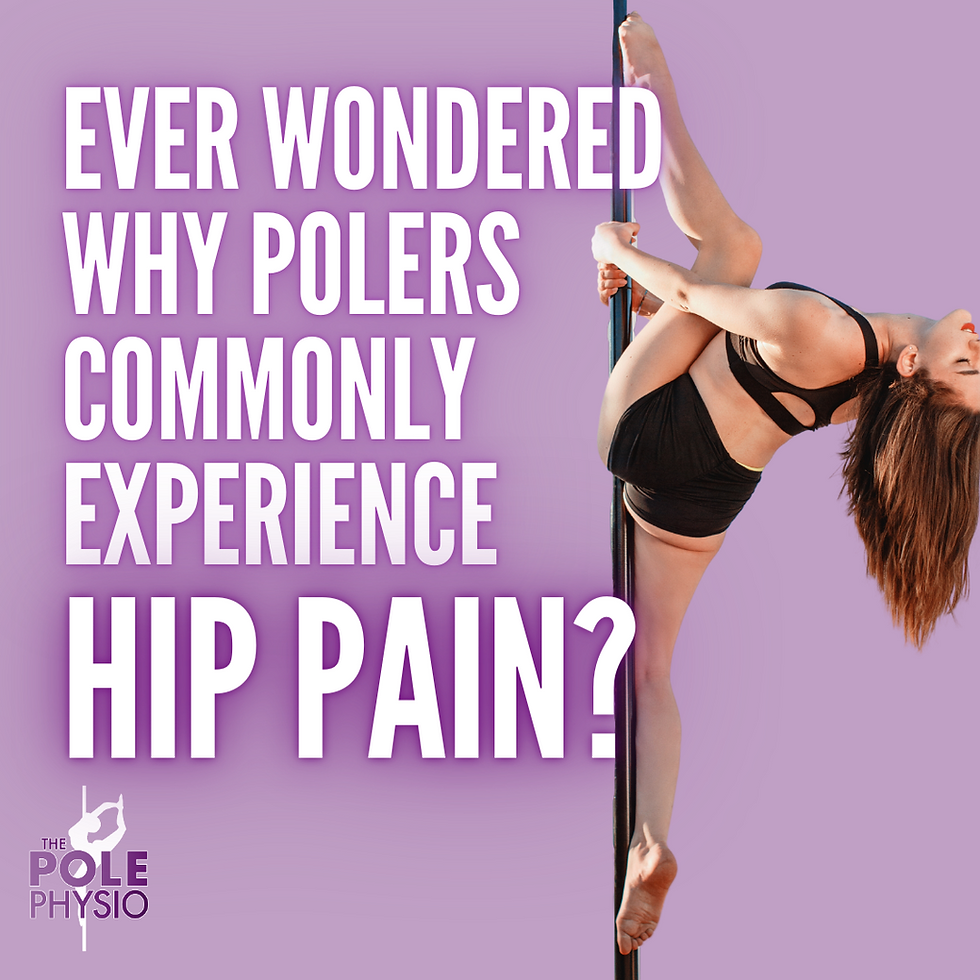
Seemingly benign in nature with initial onset, it’s not uncommon for dancers to suddenly find their hip range of motion limited or pain flared up when left untreated or ignored. Commonly patients present to our online clinic with a 6+ month history of gradually worsening hip pain before they have attempted to address it.
So, we are writing this blog in the hope to address the somewhat relaxed approach to hip injury within the pole world. When addressed early with appropriate medical care, these injuries resolve quickly and settle well. However, when left for prolonged periods of time, we can expect to see prolonged rehab experiences and reduction in pole performance.
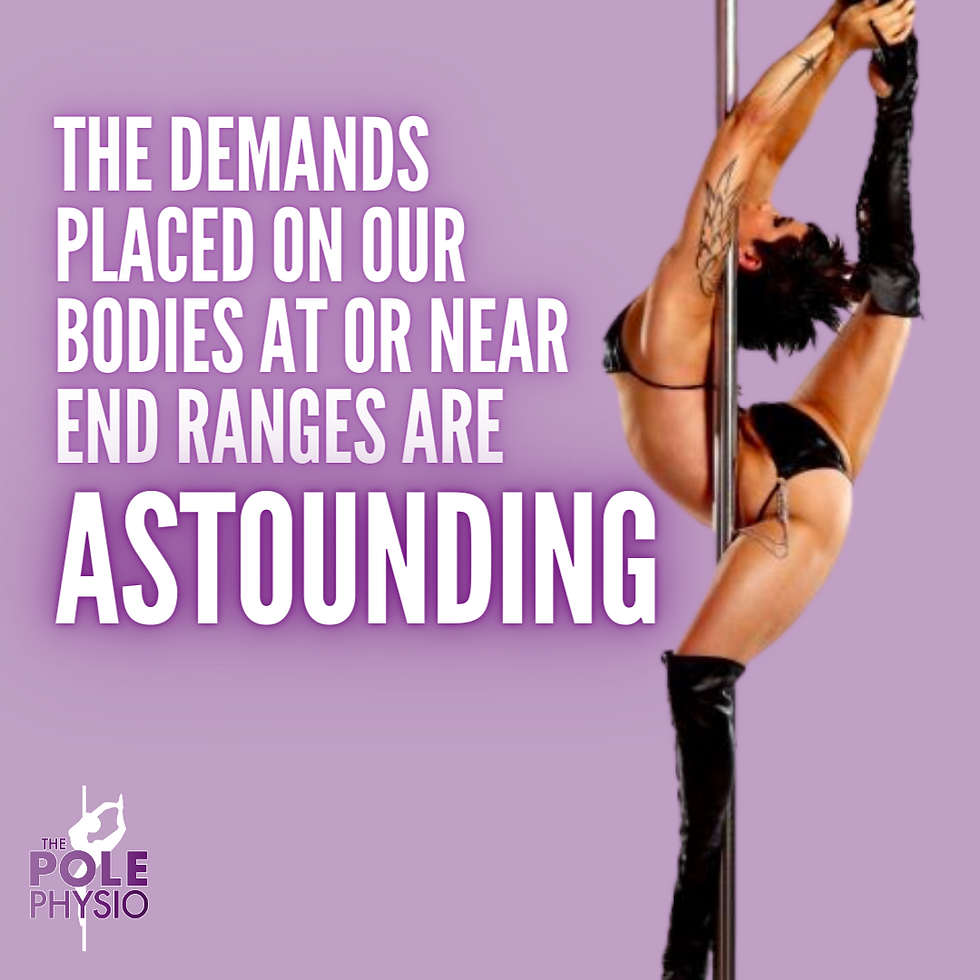
Before tackling such a large topic, it’s important to recognise that there are quite a large range of sources of hip pain and we won’t be able to cover every single one of them in this article.
And if you’re looking for the answer to what’s causing your individual hip pain and how to fix it, then you won’t find it here. Appropriate assessment and care from a health care professional is always required to ensure optimal outcome of treatment. We (the healthcare world) cannot provide a band-aid approach and treat all hip injuries the same. Assessment and a tailored approach are always required.
And when it comes to injury rehabilitation, nuance and care are required, and no two health care professionals are the same. So, ensure you’re receiving care from someone that understands your body and the demands you place on it as a pole dancer. Appointments with our online team can be booked here. We pride ourselves on providing expert assessment and care specific to pole and aerial bodies and unlike most health care professionals, we understand the demands you place on your body when you train.
Let’s begin by covering the common causes of AHP and factors that may be contributing to its development.
Causes of Anterior Hip Pain
Let’s talk pain. It can be an enigma at times, but what we know for certain is that it is an output of the brain, with the output influenced from a variety of factors. The WHO definition of pain is ‘an unpleasant sensory and emotional experience associated with, or resembling that associated with, actual or potential tissue damage’.
Pain can be driven by nociceptive (local), neurogenic (nerve) or psychosocial (central) inputs, and often it has a component of all three that need to be addressed. In our blog today we will be focusing on the local drivers of AHP – aka the things that might cause pain around the front of the hip joint. These include the joint, bone, soft tissue/connective tissues, and local nerves.

At the level of the joint, we may be experiencing pain from a range of structures including:
- Hip capsule
- Iliofemoral and pubofemoral ligaments (connecting into the capsule)
- Synovium/plica
- Acetabular labrum
- Bursa
- Fat pads
- Subchondral surface/bone

When it comes to soft tissue we are looking at:
- Quadriceps
- Iliopsoas
- Adductors
With nerves we may experience local nociceptive pain related to injury to our:
- Femoral nerve
- Genitofemoral nerve
- Obturator nerve
- Lateral femoral cutaneous nerve
- Ilioinguinal nerve
- Iliohypogastric nerve
And lastly when it comes to bone related pain, we are looking at injuries such as:
- Femoral acetabular impingement syndrome
- Femoral malversion
- Slipped upper femoral epiphysis
- Stress fracture
Soooo, it’s a lot. And that is purely at the level of the front of the hip. I.e this list doesn’t include potential referred pain from the back/pelvis and abdomen/pelvis.
See why we impress the importance of seeing a health care professional? No two of these injuries are treated the same. And so many of these injuries are often missed or undiagnosed in the poler as they are uncommonly seen in the non-pole community. So get yourself seen to be a member of our team asap.
Now we’re not going to leave it there today with just a list of potential causes of AHP. Let’s chat through a few common injuries we see and some interesting factors surrounding them:
Acetabular Labral Tears
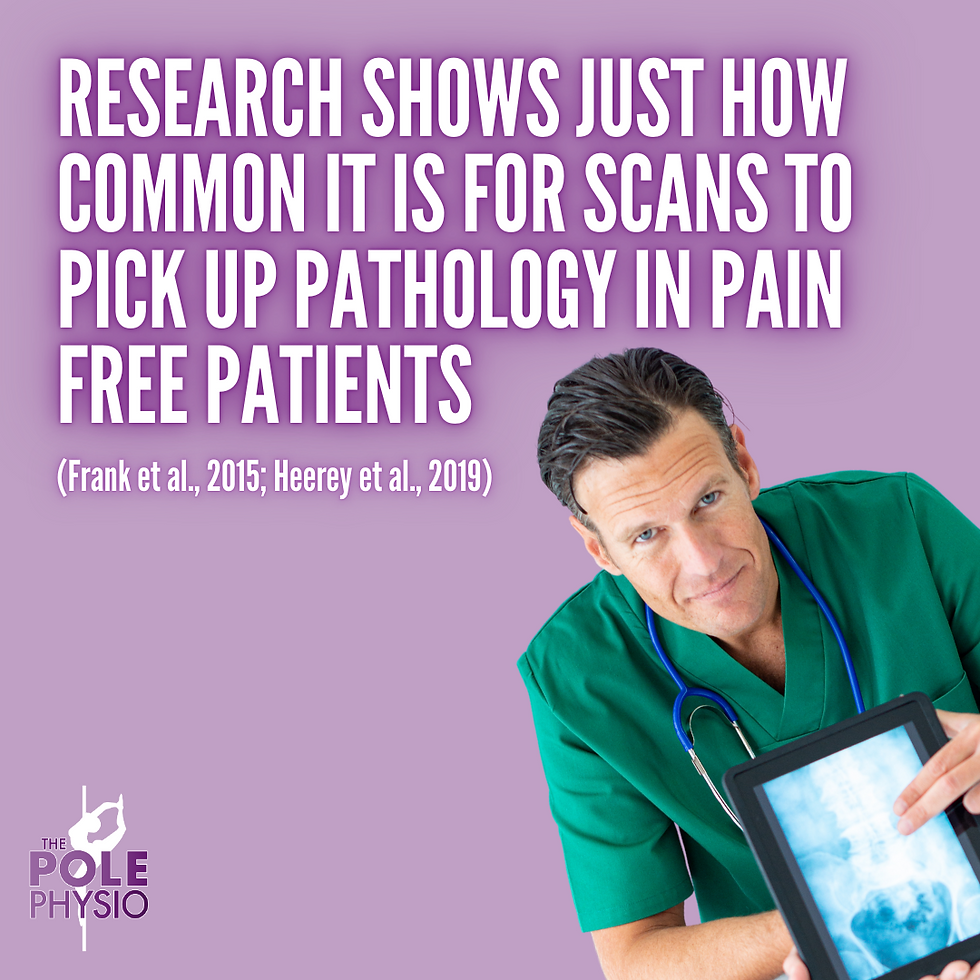
Been told you’ve got a labral tear? You’re not alone. It’s a common injury within the pole and non-pole community, and yes a labral tear can cause AHP. HOWEVER, whilst they can cause hip pain it doesn’t mean they are.
Often imaging will pick up a labral tear, but one of our favourite systematic reviews in 2018 shows that 54% of individuals WITHOUT hip pain who underwent imaging had a labral tear (Heerey et al., 2018).
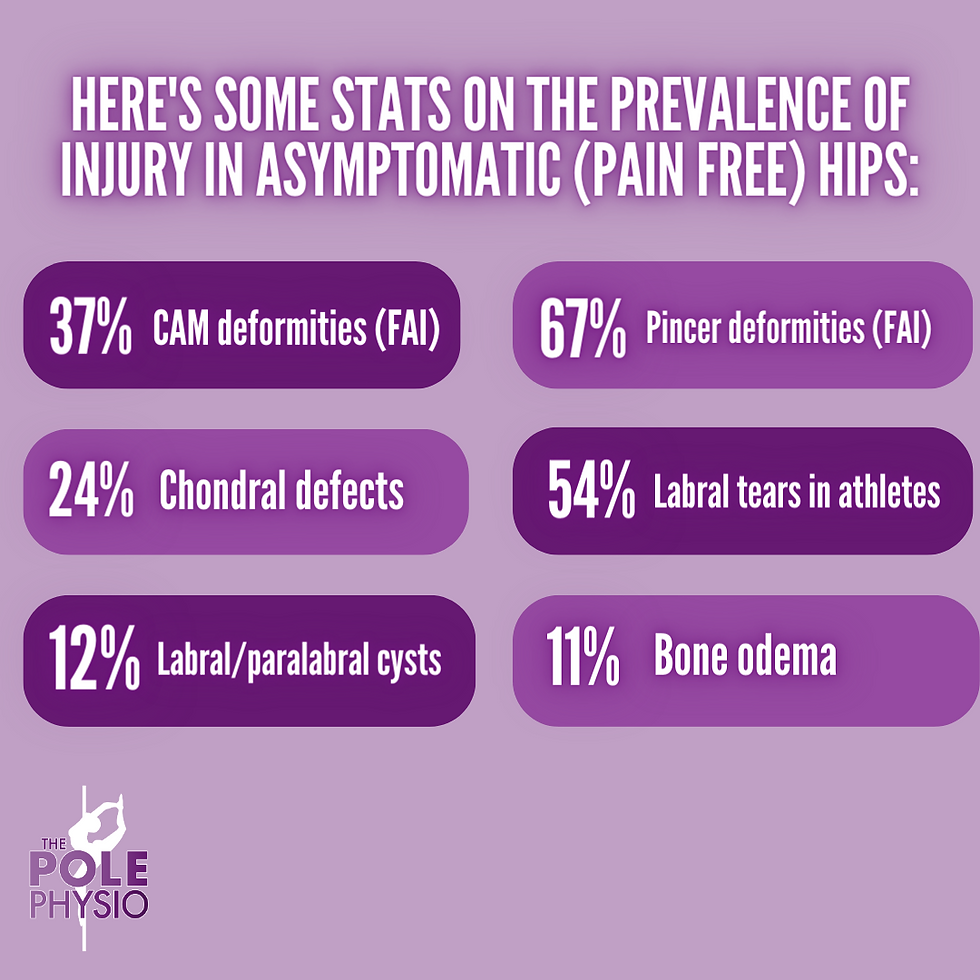
So don’t rush off from a scan when you are injured! Imaging findings do not determine treatment. So how do you know if you have a labral tear that’s contributing to AHP? Quite simply, get assessed. Clinical assessment from an experienced health care professional is the most appropriate way to determine your care management plan.
Ligamentum Teres Tear
Known as a dancer’s injury, the prevalence of a ligamentum teres tear in those with hip pain is between 43-51%, with only about 2% of those without pain displaying ligamentum teres injury (Martin et al., 2019). So what we can see from this study is that 1 in 2 individuals with anterior hip pain were likely to have involvement of the ligamentum teres. So is this ligament important?
Yes and no.
There’s still a great deal that our medical community needs to learn about this ligament, but the good news is that you can function without one. However there has been some reports of higher prevalence of secondary labral and chondral (bone surface) injury when a ligamentum teres injury is sustained (Martin et al., 2019) and they do appear harder to rehabilitate than those with a labral tear alone (Kaya et al., 2014).
Synovitis/bursitis

Common injuries of the anterior hip in pole dancers seen by our team are synovitis and bursitis. We have grouped these two separate injuries together as they commonly occur hand in hand and via a similar mechanism. The anterior hip synovium and hip flexor bursa are compressed when training end of range hip positions such as our front splits. With end of range positioning comes compression and increased risk of injury, particularly when coupled with hypermobility and lack of strength at end of range of motion. This pain is often characterised by a pinching deep pain over the front of the hip that is mistaken for hip flexor pain, but can progressively worsen when not treated appropriately. So, here’s another reminder to have your pain/injuries seen to immediately!
Factors Contributing to Anterior Hip Pain
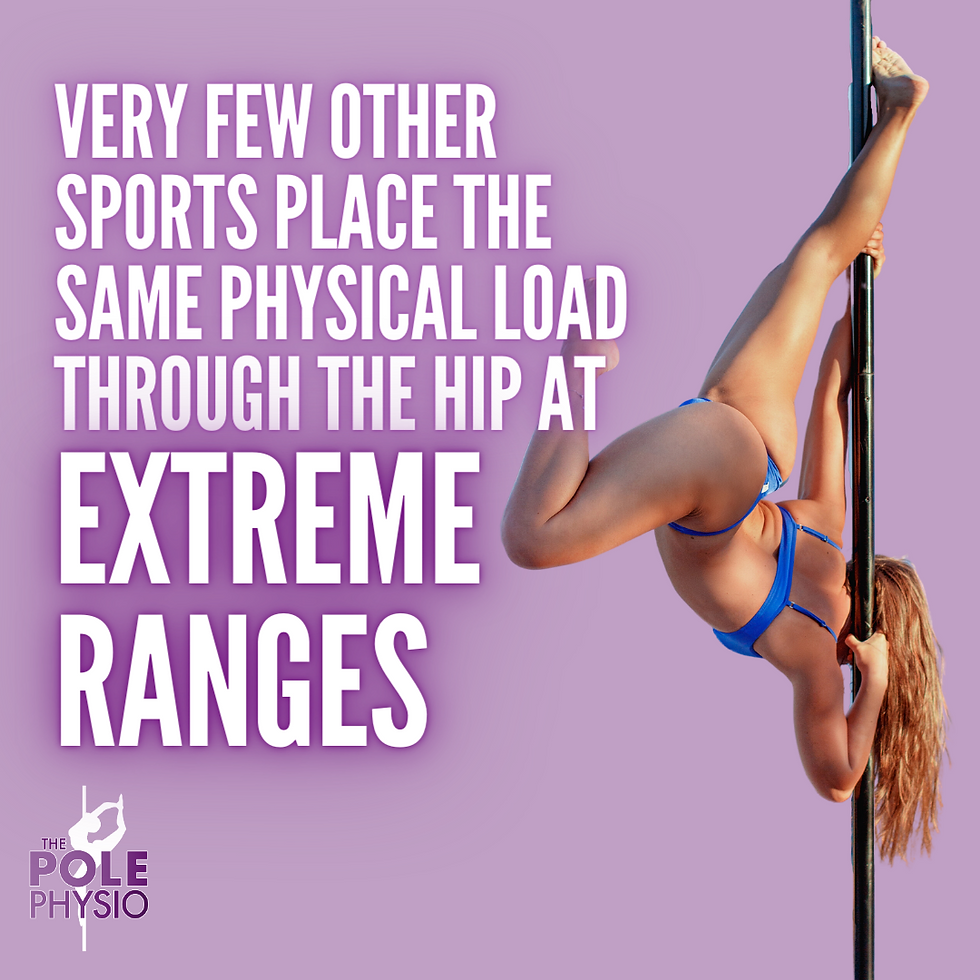
So, we now know that there are many causes of AHP, but ever wondered what may predispose you to that pain to start with?
Well, there are quite a few factors that we can talk about. Some are non-modifiable factors such as genetics, sex, past Injury and bony morphology (shape), and there are also our modifiable factors that include load management, psychosocial factors, and local muscular impairments.
Specifically in pole dancing and aerial we often deal with a hypermobile population – and majority of these hypermobile individuals don’t even realise they are hypermobile to begin with! Hypermobile spectrum disorders (HSD) including but not limited to Ehlers Danlos Syndrome (EDS) have collagen laxity which pre-dispose them to AHP. These populations often require unique approaches in the assessment and treatment of their injury. Screening for hypermobility is a must within our population as we are working in extreme ranges of motion. And remember hypermobility is NOT flexibility. You can be non-flexible and still hypermobile. Read more on hypermobility here.
Let’s talk through a few interesting bone morphology factors that can contribute to AHP now.
Femoroacetablular morphology
We are all unique and born with slightly different variations in shape/size etc. And throughout life our body will uniquely change even more. Additional bone growth at the femoral neck junction is known as cam morphology, whilst additional bone growth at the acetabular rim is known as pincer morphology. Both of these additional growths may lead to early bone contact at end range hip motion.

These bony growths are more prevalent in those who regularly force their hip into end of range positions of impingement (cough cough pole dancers), and may contribute to hip pain over time. Pain associated with this end of range contact may occur and is known as femoroacetablular impingement syndrome, or you may have heard it referred to as FAI. Those with cam morphology have a three times greater risk of requiring hip replacement surgery (Ahedi et al., 2022). So how can we reduce our risk of injury whilst maintaining our splitty positions? Focus on actively strengthening our hips at end ranges of motions instead of passive stretching alone. Supporting the hip at its end of range is imperative for long term hip health.
Femoral malversion
Now we’ve spoken about changes to the bony shape of the femur, but when we have changes to the orientation of the femur, this is known as femoral malversion. We typically have a slighted anteverted femur of about 10 to 20 degrees, but a femur with excessive version is known as anteverted and the opposite rotation is referred to as retroversion. Malversion of the femur can be due to breech positioning, genetics, sex (females>males), and development factors including physical activity, W-sitting etc.



Femoral malversion can result in alterations in gait but also will affect our hip capacity for certain movements, with particular emphasis on end of range positions such as splits. Malverted hips may still be able to perform those positions but may be at higher risk of injury if not correctly guided or strengthened for their hip morphology at these extreme ranges of motion. Excessive femoral anteversion is a risk factor for severe hip osteoarthritis whilst femoral retroversion results in femoroacetablular impingement over a broad area of the hip with increased risk of developing associated pain. Femoral malversion can be assessed by our online team of therapists with a series of specific tests.
Acetabular dysplasia

Lastly, it’s important to mention that we can have abnormal development or under coverage of the hip socket known as acetabular dysplasia (Wilkin et al., 2017). Acetabular dysplasia is screened for in the early stages of childhood these days, but can still be missed. It is more common in first born children, breech positioning, in females, those with hypermobility spectrum disorders and with swaddled babies. Which is one of the reasons why we do not encourage swaddling of infants. Ensure your babies have the room to move their legs! So why is acetabular dysplasia a risk factor for hip pain? Research shows that individuals with acetabular dysplasia increase the load through the labrum (Henak et al., 2011) and are at a much higher risk of muscular impairments and hip osteoarthritis (Jacobsen et al., 2017).
Can we reduce our risk of AHP?
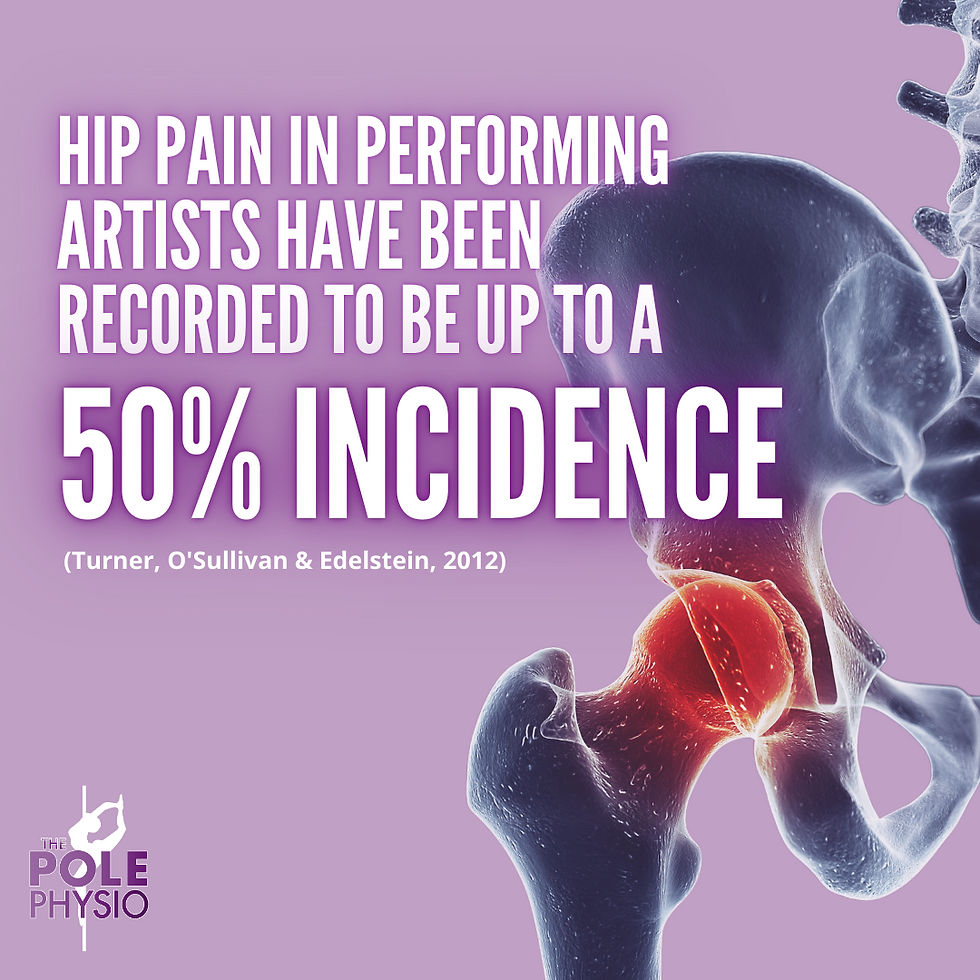
Unfortunately, we cannot address those non-modifiable risk factors that were mentioned earlier, but we absolutely can address the non-modifiable risk factors by ensuring our muscular strength, movement patterns and hip loading strategies are efficient to our bony morphology.
Good control and strength through our hip stabiliser muscles can reduce acetabular loading significantly, which is thought to provide some degree of a protective result.
And remember, your individual bony anatomy will influence the way in which your hip joint tolerates and directs load. Working with your body whilst pole dancing is essential, so understanding your individual anatomy and loading it in a gradual and progressive fashion over time to progress in your pole journey is the easiest way to reduce your risk of injury.
So, if you’re wanting to learn more on how to progress through pole whilst reducing your risk of hip injury, or if you’re wanting to address an already present hip injury, then touch base with our online physios. They understand pole, they understand hips, they understand pain, and they know how to get you the results you desire. Chat with them to create your individual management plan.
Online telehealth appointments can be booked via our ‘Book Online’ page that can be found here. Assessment and tailored rehabilitation are provided in accordance with best practice and evidence-based treatment to help you unleash your 'pole-tential'.
Until next time, train safe.
The Pole Physio
x
References:







Khám phá f8bet8, nhà cái cá cược trực tuyến uy tín với trải nghiệm casino hiện đại. Đăng ký ngay nhận 58K, tận hưởng khuyến mãi hấp dẫn và hỗ trợ 24/7. Trải nghiệm tuyệt vời tại f8beta2 support!
OKFUN mang đến trải nghiệm cờ bạc giải trí độc đáo, đa dạng trò chơi hấp dẫn. Khám phá thế giới giải trí hiện đại tại okfunn com – điểm đến lý tưởng cho mọi hội viên.
Trải nghiệm thế giới casino Ma Cao đẳng cấp khi tải sunwin. Hàng loạt game bài hấp dẫn đang chờ bạn khám phá. Truy cập sunwinn deal để nhận link tải ứng dụng mới nhất!
Truy cập f8bet008 com để f8bet đăng nhập nhanh chóng, an toàn, bảo mật cao. Khám phá thế giới game cá cược, casino, đá gà và thể thao đỉnh cao, hoàn toàn miễn phí!
hitclub là sân chơi đổi thưởng hấp dẫn, minh bạch và an toàn. tải hitclub tại hitclub1 bz để bắt đầu hành trình giải trí đỉnh cao cùng hàng triệu người chơi khắp cả nước.